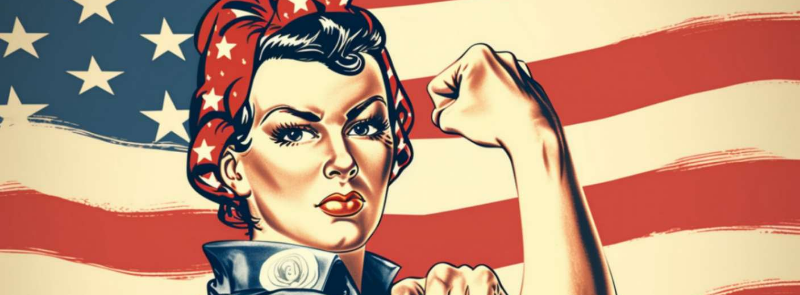
When It Occurs
Every March 21st
Timeline
Days Passed (571)
# Hashtags
#NationalRosieTheRiveterDay #WomenEquality
March 21st marks the celebration of Rosie the Riveter Day, a tribute to the vital role American women played in the victory of the United States during World War II. In the early 1940s, as the war unfolded, the enlistment of able-bodied men for the war effort left a void in the workforce, prompting a call for women to step into crucial roles. Rosie the Riveter symbolizes the millions of women who left their homes to work in factories, ensuring the continuity of the country's manufacturing processes. After sustained activism spanning decades, the U.S. Congress acknowledged this cultural icon by designating March 21 in her honor.
History and Origins of National Rosie the Riveter Day
-
Creation of the Day:
- National Rosie the Riveter Day was established as a day of recognition in 2017 by the U.S. Congress through a resolution that designated March 21st as a day to honor the legacy of Rosie the Riveter and the women she represents. The day was created to acknowledge the significant impact of these women on American history, the workforce, and the progress of gender equality.
-
The Origin of "Rosie the Riveter":
- The term "Rosie the Riveter" was popularized during World War II and became synonymous with the women who worked in industrial jobs, particularly in the manufacturing of military equipment. The name "Rosie" is believed to have originated from a song titled "Rosie the Riveter," which was released in 1942 and became a national hit. The iconic image of Rosie the Riveter, with her rolled-up sleeves and the slogan "We Can Do It!," was created by artist J. Howard Miller and became one of the most famous symbols of women's empowerment.
-
Purpose:
- The primary purpose of National Rosie the Riveter Day is to honor the women who answered the call to work during World War II and to recognize their contributions to the war effort and the workforce. The day also serves as a reminder of the progress made in gender equality and the ongoing efforts to ensure equal opportunities for women in all areas of society.
Significance of National Rosie the Riveter Day
National Rosie the Riveter Day holds significance for several reasons:
-
Honoring the Contributions of Women During WWII:
- The day honors the millions of women who worked in factories, shipyards, and other industrial jobs during World War II. Their labor was essential to the success of the Allied war effort, and they helped to produce the weapons, vehicles, and supplies needed to win the war.
-
Celebrating Women's Empowerment:
- Rosie the Riveter has become an enduring symbol of women's empowerment and the ability of women to succeed in roles traditionally held by men. National Rosie the Riveter Day celebrates this empowerment and the breaking down of gender barriers in the workplace.
-
Recognizing the Impact on Gender Roles:
- The influx of women into the workforce during World War II challenged traditional gender roles and laid the groundwork for future advancements in women's rights. National Rosie the Riveter Day recognizes this impact and the ongoing efforts to achieve gender equality.
-
Inspiring Future Generations:
- The legacy of Rosie the Riveter continues to inspire future generations of women to pursue their goals, take on leadership roles, and challenge societal norms. The day encourages young women to recognize their potential and strive for success in any field they choose.
How to Celebrate National Rosie the Riveter Day
There are many ways to celebrate National Rosie the Riveter Day, whether by learning more about the history of Rosie the Riveter, honoring the women who worked during WWII, or promoting gender equality:
-
Learn About the History of Rosie the Riveter:
- Take some time to learn more about the history of Rosie the Riveter and the women who worked in industrial jobs during World War II. Research the role these women played in the war effort and how their contributions helped to shape the modern workforce.
-
Visit a Rosie the Riveter Museum or Historic Site:
- If possible, visit a museum or historic site dedicated to Rosie the Riveter and the women of WWII. The Rosie the Riveter/World War II Home Front National Historical Park in Richmond, California, is one such site that offers exhibits, tours, and educational programs about the contributions of women during the war.
-
Honor a Rosie in Your Community:
- If you know a woman who worked during World War II, take the opportunity to honor her on National Rosie the Riveter Day. Whether through a visit, a phone call, or a letter, express your appreciation for her service and contributions to the war effort.
-
Wear Red and White Polka Dots:
- Celebrate the day by wearing red and white polka dots, a pattern often associated with Rosie the Riveter. This simple act can be a fun way to show your support for the legacy of Rosie and the women she represents.
-
Support Women's Rights and Gender Equality:
- Use National Rosie the Riveter Day as an opportunity to support women's rights and gender equality. This could include advocating for policies that promote equal pay, workplace diversity, and women's leadership, or supporting organizations that work to advance gender equality.
-
Share the Story of Rosie the Riveter on Social Media:
- Share the story of Rosie the Riveter and the significance of National Rosie the Riveter Day on social media. Use hashtags like #RosieTheRiveterDay or #WeCanDoIt to spread the message and encourage others to learn more about this important chapter in history.
-
Watch Documentaries or Films:
- Watch documentaries or films that highlight the contributions of women during World War II. Many films, such as "The Life and Times of Rosie the Riveter" and "A League of Their Own," offer insight into the lives of these women and the impact they had on society.
-
Educate and Inspire Others:
- Take the opportunity to educate others about the significance of Rosie the Riveter and the contributions of women during WWII. Whether through a presentation, a classroom lesson, or a community event, sharing this history can inspire others to recognize the importance of gender equality and women's empowerment.
Fun Facts About Rosie the Riveter
-
Iconic Image: The "We Can Do It!" poster, featuring Rosie the Riveter, was originally created by J. Howard Miller for Westinghouse Electric as part of a campaign to boost worker morale during WWII. The image later became an iconic symbol of women's empowerment.
-
Real-Life Rosies: While the character of Rosie the Riveter is a fictional representation, she was inspired by real women who worked in defense industries during the war. One of the most famous real-life Rosies was Rose Will Monroe, who worked as a riveter at the Willow Run Aircraft Factory in Michigan.
-
Cultural Impact: Rosie the Riveter has become a lasting symbol of feminism and the power of women in the workforce. The image and slogan "We Can Do It!" continue to be used in campaigns promoting women's rights and gender equality.
-
Rosie the Riveter Day of Remembrance: In addition to National Rosie the Riveter Day, there is also a Rosie the Riveter Day of Remembrance observed on March 21st to honor the legacy of the women who worked on the home front during WWII.
Conclusion
National Rosie the Riveter Day is an important observance that honors the women who stepped into roles traditionally held by men during World War II. These women not only contributed significantly to the war effort but also paved the way for future generations of women to enter the workforce and challenge gender norms. By celebrating National Rosie the Riveter Day, we recognize the resilience, strength, and determination of these women and continue to promote the values of equality and empowerment that Rosie the Riveter represents.


